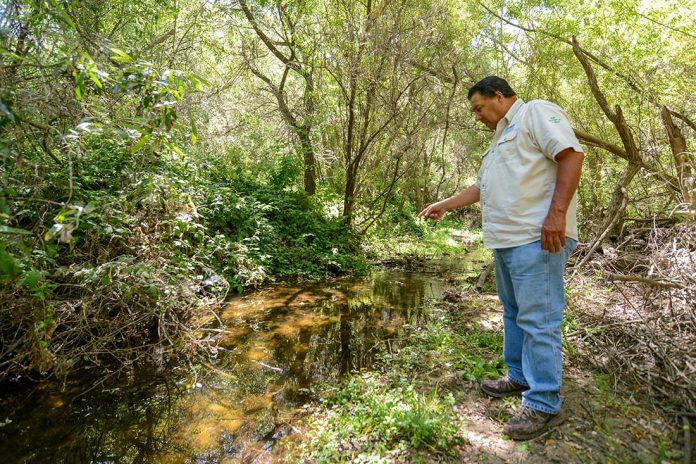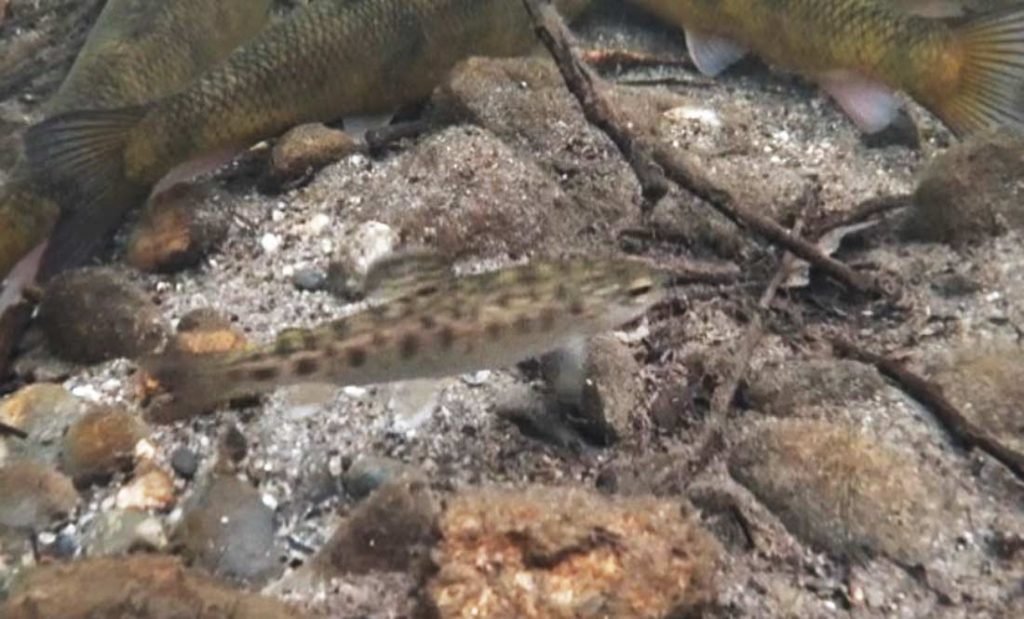
After 75 years of abuse and countless tons of garbage dumped into it, all it took was 18 months of work from dedicated volunteers to get the San Benito River on the road to recovery.
Just a few weeks ago, a discovery was made in the river in what environmentalists are calling an historic milestone for the Pajaro River Watershed: The threatened steelhead trout are back in the river in the first confirmed sighting in three-quarters of a century.
Herman Garcia, founder of Gilroy-based Coastal Habitat Education and Environmental Restoration (CHEER), made the discovery by happenstance on a recent tour of the river, where it meets up with the Pajaro River adjacent to the Betabel property along Highway 101 at the northern end of San Benito County.
“This is huge, historic news,” Garcia said.
Landfill along the river
About 18 months ago, Graniterock enlisted CHEER and its team of volunteers to clean up the San Benito River on property it owns south of Buena Vista Road in Hollister.
The volunteers were kept busy. Garcia said they were removing “thousands of pounds” of trash every day, which by the end of the work included 14 cars and trucks, one RV and two ski boats, along with 420 tires and plenty of other junk.
At the same time, CHEER gained access to the confluence of the San Benito and Pajaro rivers on the Betabel property, which is owned by the McDowell Charity Trust. That property includes a half-mile of both rivers.
Rider McDowell of the trust said when they purchased the 112-acre property adjacent to the Betabel RV Park a number of years ago, they knew it would need some major reclamation work before they could begin with plans to build a vintage-themed roadside stop.
“It was so polluted in so many ways,” he said.
On one side were 170 junked vehicles, where an illegal chop shop was operating, McDowell said. About 10 people were living in mobile homes on the property, while a doublewide trailer served as a meth lab.

Things were even worse deeper into the property toward the San Benito River.
“We didn’t even extrapolate how bad it would be further back in the watershed,” McDowell said. “It was a landfill down there. There was so much junk. People had been using it as a dumping ground.”
It was around this time McDowell met Garcia, who gave him access to the property to begin the arduous task of restoring the polluted river.
“I started deep diving into the brush,” Garcia recalled. “I’m discovering all this garbage. I mean, tonnage of garbage. Down the river banks, in the river channels, in the floodplain. It was a mess. I said, ‘Rider, you bought a landfill, man.’”
Garcia, who called the confluence “just about the heart of the watershed,” said when it rains, much of the waste from as far north as Cochrane Road in Morgan Hill finds its way downstream to Watsonville and the Monterey Bay.
The volunteers went to work, pulling out roughly 3,000 to 5,000 pounds of trash every day, according to Garcia.
Their efforts from both the Betabel and Graniterock properties were rewarded.
Clean water attracts steelhead
Steelhead trout require “good to very good” water quality for their habitat, Garcia said.
As such, the fish avoided the San Benito River for roughly 75 years.
“It was all polluted and nasty,” Garcia said. “They didn’t even think about going in there.”
A 2010 report by the California Department of Fish and Game cited studies from 1913 and 1934, where juvenile steelhead were collected at the Pajaro River near the San Benito River confluence. A 1959 study by the department reported an absence of juvenile steelhead in the area.
The National Oceanic and Atmospheric Administration reported in 2013 that the dry conditions of the San Benito River has “limited potential” to provide a habitat for juvenile steelhead.
A few weeks ago, Garcia was giving a tour of the river on the Betabel property when at one point he had to jump over the creek. As he did so, he noticed what looked to be a startled juvenile steelhead darting out of the way underwater.
He enlisted the help of a photographer, who captured video of the fish both underwater and jumping out of it to catch bugs floating along the river. The video was sent to the National Oceanic and Atmospheric Administration, where they confirmed that the juvenile fish were indeed steelhead trout. The fish are now migrating into the Pajaro River and eventually the Monterey Bay.

“The reclamation work that we did had a significant impact on the water quality and the health of the ecosystem,” Garcia said.
A healthy watershed also has economic benefits, he noted, such as boosted property values.
Restoration work continues
Garcia said CHEER’s work is far from finished.
“We are going to continue our maintenance work,” he said. “To be sustainable, we can’t stop.”
The organization plans to jump in and put its “fine touch” on Llagas Creek in San Martin—a few miles north in Santa Clara County—as that creek flows into the Pajaro River, following Graniterock’s work to expand the capacity of the creek as part of a flood control project.
Garcia is thankful for the support CHEER has received throughout its efforts. Graniterock and the McDowell Charity Trust provided financial support for the nonprofit to purchase a trailer, while Recology South Valley waived all fees for CHEER to transfer the debris to the San Martin Transfer Station.
McDowell called the return of steelhead trout a “major development,” and gave all credit to Garcia and CHEER.
“We were the passive party here,” he said. “The one that did all the work was Herman. He is a powerhouse.”
Garcia called CHEER the “first line of defense in the Monterey Bay, and the last line of defense in the lower watershed.”
“If it wasn’t for all the work that CHEER has done, Monterey Bay would be a mess,” he said. “Our group of volunteers is doing a tremendous job protecting the marine sanctuary.”














I think the meth lab may have moved to river by brigantine park,Hollister. I saw a really nice mobile home there. I was too scared to check it out. Tons of gutted out cars all over the place. I only saw 2 tents with people. It is too cold and wet for camping. -March 2023.